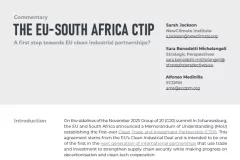Long-term low greenhouse gas emission development strategies are essential to plan short-term steps for greenhouse gas emission reduction and to set targets for the second round of nationally determined contributions. Such long-term strategies should focus on full decarbonisation in line with the Paris Agreement’s long-term goals for each sector and the required financial resources to implement them. This blog provides reasons why.
Introduction
2018 marks an important year for the UNFCCC climate negotiations as the details of the Paris Agreement, the “Paris Agreement implementation guidelines”, need to be worked out.
At the core of the Agreement is the ambition mechanism which calls for countries to present (and implement) progressively more ambitious Nationally Determined Contributions (NDCs) every five years in order to arrive at a collective level of mitigation ambition to limit average global temperature increase to “well below 2°C” and work towards 1.5°C. In support of this mechanism parties participate in a global stocktaking exercise starting this year with the Talanoa Dialogue, to be repeated every five years, in order to review and exchange on where the world stands with regards to the implementation and goals of the Agreement.
The current aggregate level of ambition of NDCs falls well short of what is required to keep the world on track towards a Paris compatible pathway (UNEP 2017). Urgent action is needed to identify how to improve NDCs in the short-term in order to align them with the long-term perspective.
Whilst initially the post Paris debate seems to have focussed on NDCs, increasingly, attention is shifting towards long-term or mid-century strategies (LTS). Article 4, paragraph 19 of the Paris Agreement requests national governments to formulate long-term low greenhouse gas emission development strategies by 2020, taking into account their common but differentiated responsibilities, respective capabilities and national circumstances (FCCC 2015). Eight countries have currently presented such long-term strategies: the United Kingdom, Czech Republic, France, Benin, the United States of America, Mexico, Germany and Canada (see https://unfccc.int/process/the-paris-agreement/long-term-strategies), with several other countries reportedly in the process of preparing such strategies (NewClimate Institute; ECN 2017).
This blog provides some initial reflections on the important role of LTS for the NDC process, also in the context of the Talanoa Dialogue and the Global Stocktake in 2023. It asks the questions of “What is a long-term GHG development strategy?”; “Why is a LTS essential for short-term planning?”, and “How to develop a fair and equitable LTS?”, in particular considering the implementation of actions and providing and receiving support
What are long-term low GHG emissions development strategies?
It is important to get a common understanding of what LTS actually are and what they should cover. Different interpretations of their scope seem to exist, depending on the different perspectives a stakeholder might have.
As evidenced by a recent survey (NewClimate Institute; ECN 2017) nearly half of the countries in the survey reported that LTS have already been developed and signed off or are close to being finalised. These are generally developing countries, which have previously gone through comprehensive processes to develop low emission development strategies (LEDS) or similar exercises.
Regarding the scope, questions arise of whether LTS should:
- Also include adaptation,
- cover strategies for the implementation of the sustainable development goals, and
- be clearly compatible with the Paris Agreement long-term goals - and if so - how that is determined.
The text of the Paris Agreement sets a clear marker on the focus on mitigation of climate change for LTS calling them “long-term low greenhouse gas emission development strategies”. Considering the long-term goals of the agreement and the scientific evidence that full global decarbonisation is needed by the second half of the century, an interpretation of the LTS as national or sectoral decarbonisation strategies is reasonable. The long-term goals of the agreement also clearly separate them from previous LEDS processes, which did not have such a clear link to the global temperature target.
It is clear that especially for least developed countries, adaptation and resilience building as well as the overarching role of the sustainable development goals (SDGs), are high priorities – and of course LTS or decarbonisation strategies need to consider potential synergies and trade-offs. However, there is a risk that LTS become another comprehensive strategy exercise which absorbs significant resources and capacities and may duplicate existing or past processes. To play the role that LTS need to, it is important that they are defined as decarbonisation or “well below 2°C” transition strategies. They are the opportunity to undertake a much needed exercise – in developed and developing countries alike – to fully understand the implications of the Paris goals for economies in the long term at the national as well as sector level.
Why are the strategies essential for short-term planning?
Understanding what the long-term Paris goals mean at the national and sectoral level seems to be lacking across most countries. At the same time, a long-term vision of what a fully decarbonised economy and/or sector may look like is crucial in order to develop effective policy responses as well as to inform business and investment strategies. Business in particular benefit from a clear long-term direction, political consensus and continuity to enable and constructively contribute to a (smooth) transition process.
At the climate policy level, LTS are essential to inform the current and future NDC targets. The term “long term” itself may not provoke an immediate sense of urgency, however, decisions taken today will impact the status of the economy in 2050 and in particular how difficult/ costly it will be to get where we need to be.
An NDC process which starts from the “long term” (decarbonisation) target will provide much more certainty that the individual as well as collective level of effort will be sufficient. NDC targets can be extrapolated from where a country/ sector needs to be in 2050 and thus inform short-term planning. For example, transport infrastructure or power plants investments made today will still be around in 2050, given their life time is often longer than 30 years.
Hence, although not explicitly linked in the Paris Agreement text, LTS and short- and medium-term targets provided in the NDCs need to be linked and considered as part of one ambition process which leads to full decarbonisation.
How to develop LTS considering equity and fairness?
The Paris Agreement does not give clear guidance on how the required mitigation efforts to stay within agreed temperature limits should be distributed among countries. The Paris Agreement’s long-term temperature goals require significantly scaled-up efforts by all countries to decarbonise their economies. The agreed principle of “common but differentiated responsibilities” underlines that such decarbonisation processes will need to occur at different speeds depending on country capabilities and context.
Due to this urgency, all countries’ emissions need to peak and decline as fast as possible. The question of fairness mainly relates to what and how much support a country needs to decarbonise its economy. Hence for developing countries, it is essential to provide a clear and specific indication of the support needed to implement the transition.
Developed countries, on the other hand, need to provide sufficient financial resources to encourage the development and implementation of LTS and ultimately enable the implementation of the ambition process. Beyond the provision of financial and capacity support, developed countries also play an important role in driving down the costs for technologies that are essential for the decarbonisation of sectors (as has been the case for renewable technologies for example).
Lastly, on a more practical note, rather than developing high-level national strategies, it is most effective to focus on specific sectors, working towards one end point, e.g. a decarbonised energy sector in 2050. The process needs to be owned and driven by the sector lines ministries and stakeholders to ensure anchoring and full mainstreaming. At the same time, it is critical to consider the interplay of different sectors to ensure a coherent national approach.





